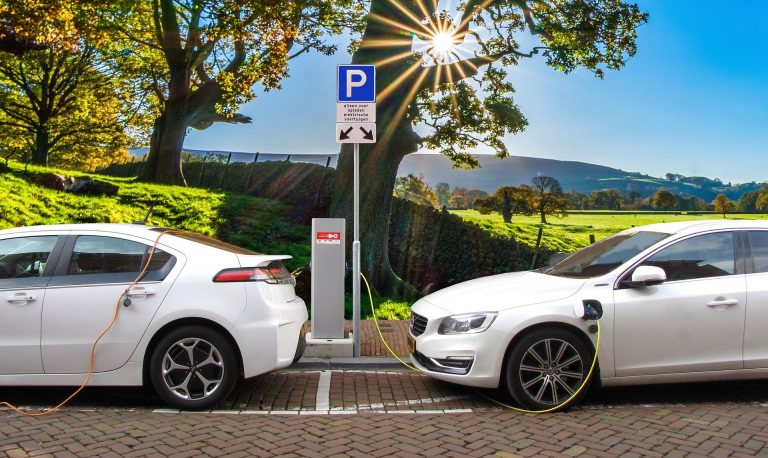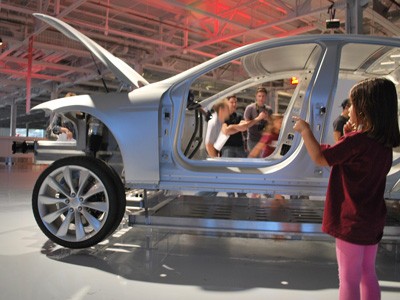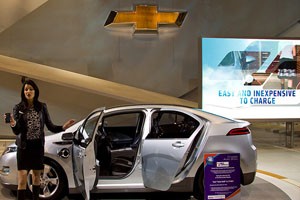On Jan. 8, automotive industry giant General Motors Co. announced a surprising rebrand. It includes a new logo — startup-like, with its rounded corners, blue gradient and lowercase initials — and a promotional campaign tailored to position GM at the forefront of a growing market for electric vehicles (EVs).
The marketing shift follows a year in which the stock price of EV producer Tesla Inc. exceeded those of the nine largest car companies combined.
GM’s new marketing expresses a desire to innovate with EVs, even as the company represents the gas-powered automotive establishment in the U.S. Its “Generation E” ad campaign bespeaks the numerous obstacles GM and other established car manufacturers face as they attempt to normalize electric cars for the population at large.
“We plug in our vehicles as naturally as we charge our phones,” a pair of pitchwomen say, holding up smartphones for emphasis; in rural areas across the Midwest, however, universal charging stations can be hundreds of miles apart.
“We don’t judge cars by the rev of an engine, but by the hum of progress,” other spokespeople add; for much of the country, though, gas-powered cars are tied to ideals of masculinity and power.
Business reporting on EVs needs to convey that, in short, not everyone in the country can transition to driving an EV with the ease and confidence of GM’s spokespeople. In other words, localized business journalism should highlight the social and logistical factors that inhibit the regional spread of EVs.
“As naturally as we charge our phones”
A lack of charging stations — especially those that accommodate non-Tesla EVs — plagues much of the country. Bloomberg News’s Kyle Stock noted the severity of the problem in the rural Upper Midwest; from Rapid City, South Dakota, the closest universal charging station is 353 miles away as the crow flies.
This scarcity is problematic for car companies trying to market EVs in the region. Denizens of rural communities have to drive longer distances in their everyday lives, which means that they would actually stand to save the most money on gasoline from using EVs, but also makes them more reluctant to acquire EVs. Business journalists covering electric vehicles locally should interview actual EV drivers to determine the extent of their “range anxiety,” as The Associated Press did in 2017.
It might be tempting to infer that EVs would better suit tightly packed urban settings. This assumption has even permeated academic research of EVs. However, reporters must resist it. In reality, compared to rural areas, densely populated cities have an opposite, but equally problematic, outlook for EVs. New York City, for instance, has a limited number of single-family homes in which personal car chargers can be installed. Indeed, the New York Times reported in April that only 5,801 electric cars were registered across the five boroughs.
The ideal setting for an electric vehicle could be the suburbs, where a personal charger in a single-family home is feasible, but the charging stations of a larger city are also within reach.
“The rev of an engine”
Even in the perfect geographical environment for an EV, prospective owners still might be deterred by a cultural stigma. The trendy term “petro-masculinity,” coined by Virginia Tech professor Cara Daggett, refers to a classically American view of patriarchal domination defined by the consumption of fossil fuels. More broadly, gas-powered cars are ingrained in American culture; this means that EVs are frequently greeted with suspicion.
As such, GM’s CMO said it needed to “challenge stereotypes” in its EV marketing. Indeed, EV apologia from the automotive industry constitutes a genre all its own.
Take for example the “Normal Now” ad campaign from Electrify America (a division of Volkswagen founded after its emissions scandal), which adopts a defensive attitude, assuring the public that electric cars are driven by “normal people,” go “normal distances,” look normal, and so on. The “look normal” point is particularly salient because of the extent to which auto manufacturers have made use of skeuomorphism in designing EVs, including superfluous aspects of gas-powered cars like grilles and engine noises for the sake of familiarity.
Journalists shouldn’t be afraid to discuss the perception of electric cars in their reporting. After all, it seems that the point of GM’s rebrand is to gradually break down the mental barriers, perhaps even more so than the logistical ones, that prevent consumers from purchasing electric cars. Reporters should therefore take care to address both these fronts when reporting locally on the adoption of EVs.










